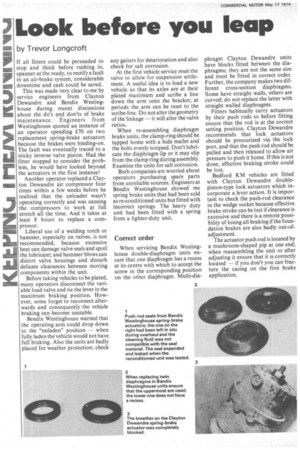Look before you leap
Page 56

If you've noticed an error in this article please click here to report it so we can fix it.
by Trevor Longcroft
If all fitters could be persuaded to stop and think before rushing in, spanner at the ready, to rectify a fault in an air-brake system, considerable downtime and cash could be saved.
This was made very clear to me by service engineers from Clayton Dewandre and Bendix Westinghouse during recent discussions about the do's and don'ts of brake maintenance. Engineers from Westinghouse quoted an instance of an operator spending 00 on two replacement spring-brake actuators because the brakes were binding-on. The fault was eventually traced to a sticky inverse valve piston. Had the fitter stopped to consider the problem, he would have looked beyond the actuators in the first instance!
Another operator replaced a Clayton Dewandre air compressor four times within a few weeks before he realized that the unloader wasn't operating correctly and was causing the compressors to work at full stretch all the time. And it takes at least 8 hours to replace a compressor.
Liberal use of a welding torch or hammer, especially on valves, is not 'recommended, because excessive heat can damage valve seals and spoil the lubricant; and hammer blows can distort valve housings and disturb delicate clearances between moving components within the unit.
Before taking vehicles to be plated, many operators disconnect the variable load valve and tie the lever in the maximum braking position. However, some forget to reconnect afterwards and consequently the vehicle braking can ,become unstable.
Bendix Westinghouse warned that the operating arm could drop down to the "unladen" position when fully laden the vehicle would not have full braking. Also the units are badly placed for weather protection; check any gaiters for deterioration and also check for salt corrosion.
At the first vehicle service reset the valve to allow for suspension settlement. A useful idea is to load a new vehicle so that its axles are at their plated maximum and scribe a line down the arm onto the bracket; at periods the arm can be reset to the scribe-line. Do not alter the geometry of the linkage — it will alter the valve ratios.
When re-assembling diaphragm brake units, the clamp-ring should be tapped home with a hide mallet and the bolts evenly torqued. Don't lubricate the diaphragm lip or it may slip from the clamp ring during assembly. Examine the units for salt corrosion.
Both companies are worried about operators purchasing spare parts from unreliable sources. Engineers at Bendix Westinghouse showed me spring brake units that had been sold as re-conditioned units but fitted with incorrect springs. The heavy duty unit had been fitted with a spring from a lighter-duty unit.
Correct order
When servicing Bendix Westinghouse double-diaphragm units ensure that one diaphragm has a recess at its centre with which to accept the screw in the corresponding position on the other diaphragm. Multi-dia phragm Clayton Dewandre units have blocks fitted between the diaphragms; they are not the same size and must be fitted in correct order. Further, the company makes two different cross-section diaphragms. Some have straight walls, others are curved; do not replace the latter with straight walled diaphragms.
Fitters habitually carry actuators by their push rods so before fitting ensure that the rod is at the correct setting position. Clayton Dewandre recommends that lock actuators should be pressurized via the lock port, and that the push rod should be pulled and then released to allow air pressure to push it home. If this is not done, effective braking stroke could be lost.
Bedford KM vehicles are fitted with Clayton Dewandre doublepiston-type lock actuators which incorporate a lever action. It is important to check the push-rod clearance in the wedge socket because effective brake stroke can be lost if clearance is excessive and there is a remote possibility of losing all braking if the foundation brakes are also badly out-ofadjustment. The actuator push rod is located by a mushroom-shaped pip at one end; when reassembling the unit or after adjusting it ensure that it is correctly located — if you don't you can fracture the casing on the first brake application.








































































































